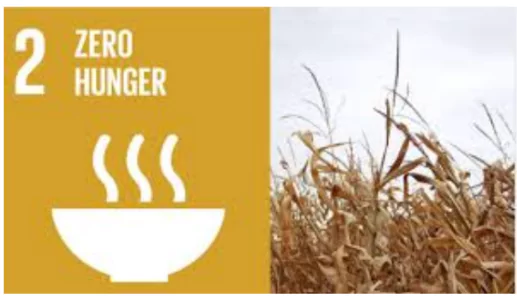The United Nations Statistical Commission introduced the Minimum Dietary Diversity (MDD) indicator to monitor global progress towards Sustainable Development Goal (SDG) 2: Zero Hunger.
- MDD focuses on ensuring that food systems prioritize nutritious and balanced diets rather than just calorie intake.
What are Sustainable Development Goals?

The Sustainable Development Goals (SDGs) are 17 global targets set by the United Nations to address social, economic, and environmental challenges, aiming for a sustainable future by 2030.
About SDG 2 Zero Hunger
- The goal is to end hunger, achieve food security, improve nutrition, and promote sustainable agriculture by 2030.
Key Targets under SDG 2
- Ensure access to safe, nutritious, and sufficient food for all people throughout the year.
- Eliminate all forms of malnutrition, especially among children under five and vulnerable groups.
- Increase sustainable agricultural productivity by promoting resilient farming practices.
- Preserve the genetic diversity of seeds, crops, and livestock to maintain sustainable food production.
Indicators to Monitor Progress in Achieving Zero Hunger
- Prevalence of undernourishment, tracking the proportion of people suffering from hunger.
- Food Insecurity Experience Scale (FIES), measuring food insecurity at individual and household levels.
- Prevalence of stunting and wasting among children under five, assessing malnutrition.
- New Indicator: Minimum Dietary Diversity (MDD), evaluating the quality and nutritional adequacy of diets.
Essential Food Groups Monitored Under MDD
- Grains
- White roots, tubers, and plantains
- Pulses (beans, peas, lentils)
- Nuts and seeds
- Milk and milk products
- Meat, poultry, and fish
- Eggs
- Dark green leafy vegetables
- Vitamin A-rich fruits and vegetables
- Other fruits and vegetables
|
About Minimum Dietary Diversity (MDD)
- The MDD indicator measures the variety and nutritional quality of food consumed.
- It is a binary (yes/no) indicator, determining whether an individual consumed at least five out of ten essential food groups in the past 24 hours.
- It specifically assesses dietary quality in two vulnerable population groups:
- Children
- Women of reproductive age
- The indicator is jointly managed by FAO and UNICEF.
Significance of the MDD Indicator
- Addressing a Key Data Gap: Previously, there was no dedicated SDG indicator to monitor healthy dietary practices, limiting efforts to assess and improve global nutrition.
- Combating Malnutrition and NCDs: Unhealthy diets are a major driver of malnutrition and non-communicable diseases (NCDs). MDD helps track dietary patterns, supporting efforts to reduce health risks.
- Enhancing Food Security and Nutrition: By focusing on dietary diversity, MDD shifts the emphasis from calorie consumption to nutrient adequacy, promoting better health outcomes and sustainable food systems.
- Strengthening Policy and Program Development: Many countries already collect MDD data to guide nutrition policies and interventions. Integrating it into SDG monitoring enables evidence-based decision-making.
- Benchmarking Global Dietary Progress: MDD provides a standardized measure for tracking improvements in diet quality, allowing countries to compare progress and refine their strategies.
- Ensuring Long-Term Dietary Monitoring: Including MDD in the SDG framework increases the likelihood of sustained monitoring beyond 2030, reinforcing its role in global health and food system transformation.
United Nations Statistical Commission (UNSC)
- UNSC is the highest body of the global statistical system bringing together the Chief Statisticians from member states from around the world.
- Establishment: The United Nations Statistical Commission, was established in 1946.
- Functions of UNSC
- It is the highest decision making body for international statistical activities.
- It is responsible for setting statistical standards and the development of concepts and methods, including their implementation at the national and international level.
- It oversees the work of the United Nations Statistics Division (UNSD).
- It functions as a commission under the UN Economic and Social Council (ECOSOC).
- Membership: The commission consists of 24 UN member countries, elected based on geographical representation.
- Each member serves a four-year term.
- India was elected to the UNSC for a four-year term starting January 1, 2024.
- Headquarters: New York, USA.
- Annual Sessions and Decision-Making: The UNSC holds annual sessions at UN Headquarters in New York.
India’s Progress on SDG 2
- Hunger Malnutrition: India has significantly reduced hunger but still faces challenges:
- Global Hunger Index (GHI) 2024 : India ranks 105 th out of 127, indicating serious hunger levels.
- Malnutrition: 35.5% of children under five are stunted, and 32.1% are underweight (NFHS-5).
Food Security Initiatives in India:
- Public Distribution System (PDS): Provides subsidized food grains to over 800 million people under the National Food Security Act (NFSA).
- PM Garib Kalyan Anna Yojana (PMGKAY): Extended free foodgrain support during the COVID-19 pandemic.
- Mid-Day Meal Scheme and PM Poshan: Provides nutritious meals to schoolchildren to combat malnutrition.
Challenges in Achieving SDG 2
- Food wastage: India loses 40% of food produced due to poor storage and supply chain inefficiencies.
- Agricultural distress: Smallholder farmers struggle with low income and climate change impacts.
- Nutritional Deficiencies: High prevalence of anemia and micronutrient deficiencies, especially among women and children.
Way Forward
- Strengthening food fortification to address malnutrition. Introduction of fortified rice under PDS is a welcome move in this direction.
- Expanding climate-smart agriculture and sustainable farming practices.
- Enhancing rural infrastructure to reduce post-harvest losses.
- Promoting diversified diets and awareness on nutrition.
![]() 13 Mar 2025
13 Mar 2025


